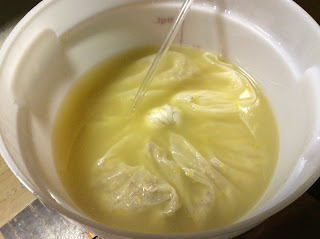I like to make wine in small batches, especially ones that I have never made before.
You don't want to make a flavor and find out after a year of waiting, that the results are not worth drinking. Bad batches of wine do happen and that's expected, but sometimes the flavors are not strong enough or are too strong and just need a bit of tweaking to make them better. That's where blending comes into play. Especially so with this particular batch of Barley wine. Yes I've been tasting this all through the winemaking process, but this is a new recipe I am developing and the flavors are just not working.
Back in early May I made a gallon of Barley Wine for the first time. I had no idea if this would be any good or drinkable. Well it's bottling time and although I have sampled the wine throughout the process of making it, I'm now finding it rather bland. However, I am also bottling the Citrus wine at the same time, which also seems not quite up to par. The Citrus wine has a bit too much flavor. The zest from the lemons are too sharp and bitter. What it needs is something to smooth out the rough edges, which may smooth out over time if left in the bottle to condition.
I decided to sample the Barley wine with the Citrus wine together and see if a blend would work. Both wines are similar enough that they would complement each other, why not find out. After trying several combinations of each, I felt that a straight 50/50 mash-up was working. They are bottled and hopefully early next year we'll toast to something special.

















